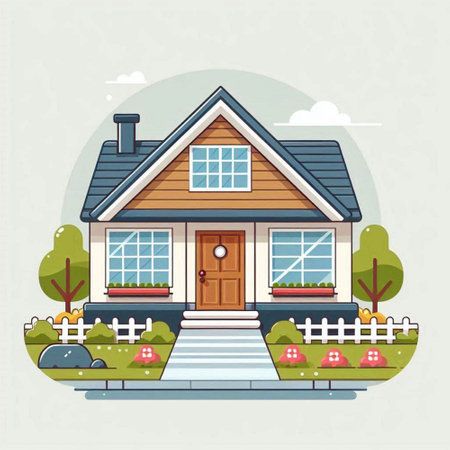1. First Impressions Start at the Curb
Before buyers even walk through the front door, they’re already forming opinions about your home. This psychological process happens almost instantly—and it starts at the curb. Known as “curb appeal,” the exterior look and feel of a property sets the tone for the entire showing. It’s not just about landscaping or a fresh coat of paint; its about how the home makes buyers feel from the moment they arrive.
Why Curb Appeal Matters
Homebuyers often make emotional decisions based on first impressions. A well-maintained exterior suggests that the inside is equally cared for, while a neglected yard or chipped paint can raise red flags. It’s all about creating a sense of trust and anticipation.
Psychological Triggers at Play
- Safety: Clean pathways, good lighting, and visible house numbers give buyers a sense of security.
- Pride of Ownership: A tidy lawn and decorated porch signal that the homeowner cares—this influences perceived value.
- Emotional Connection: Cozy details like potted plants or a seasonal wreath create an inviting, “homey” vibe that helps buyers imagine themselves living there.
Exterior Features That Influence Buyer Perception
| Feature | Positive Impact | Negative Impact |
|---|---|---|
| Lawn & Landscaping | A healthy green lawn and trimmed hedges show care and maintenance. | Overgrown grass or dead plants signal neglect and extra work for buyers. |
| Siding & Paint | A fresh coat of paint or clean siding adds to visual appeal and indicates recent upkeep. | Dirt, peeling paint, or mildew stains suggest deferred maintenance. |
| Main Entryway | A clean, welcoming front door with working hardware boosts charm and functionality. | A squeaky door or outdated fixtures can make buyers question overall condition. |
| Driveway & Walkways | No cracks or stains give a smooth, finished look and ensure safety. | Crumbling concrete or oil stains hint at future repairs and costs. |
The Emotional Timeline of Arrival
The first few minutes after arriving are critical. Buyers are subconsciously asking themselves: Does this feel like home? Is it safe? Do I feel proud walking up to this house? Your job as a seller—or agent—is to make sure those answers are yes across the board. Consider these moments:
0–30 Seconds: The Drive-Up
This is when buyers take in the entire property layout. Make sure the lawn is mowed, driveway is clean, and exterior lights are working—even during daytime showings.
30 Seconds–1 Minute: The Walk-Up
This short journey from car to front door matters more than you think. Add small touches like a new doormat, potted plants, or even soft music if appropriate. These details help form an emotional bond quickly.
The Doorstep Pause
This is when agents are unlocking the door—and buyers have time to look around. Make it count with clean windows, fresh paint on trim, and maybe even a subtle scent like lavender from nearby planters.
2. Setting the Emotional Tone with Staging
When buyers walk into an open house, they’re not just looking at walls and floors — they’re imagining a future. Smart staging helps spark that imagination by creating a warm, welcoming emotional tone that invites them to mentally move in. Strategic choices in furniture placement, lighting, and décor can subtly influence how people feel about a space.
Furniture Placement: Guiding Flow and Function
The way furniture is arranged can make a home feel spacious or cramped, inviting or awkward. The goal is to create natural pathways and highlight how each room can be used.
| Room | Staging Tips |
|---|---|
| Living Room | Arrange seating to encourage conversation; avoid blocking windows or walkways. |
| Dining Room | Use a table that fits the space without overwhelming it; add simple place settings for warmth. |
| Bedroom | Center the bed on the main wall; use matching nightstands and lamps for balance. |
Lighting: Creating Mood and Warmth
Lighting sets the mood of a home more than most sellers realize. Natural light is always best, so open blinds and curtains wide. In darker rooms or during evening showings, layer your lighting:
- Overhead Lighting: Make sure all bulbs are working and match in color temperature (soft white works best).
- Lamps: Table and floor lamps add cozy warmth to corners and reading areas.
- Accent Lighting: Use under-cabinet lights or wall sconces to highlight architectural features or artwork.
Décor: Subtle Style That Sells
Décor should enhance the home’s features without distracting from them. Keep it neutral but not boring — think soft textures, pops of color, and items that suggest a lifestyle.
Do:
- Add throw pillows and blankets in calming tones.
- Use fresh flowers or bowls of fruit in kitchens and dining areas.
- Hang mirrors to reflect light and make spaces feel larger.
Avoid:
- Personal photos or monogrammed items — these remind buyers it’s someone else’s home.
- Loud colors or bold patterns that could turn off potential buyers.
- Toys, clutter, or overly themed decorations that limit imagination.
The Emotional Payoff
A well-staged home feels like a fresh start — not just for living, but for dreaming. When buyers emotionally connect with a space, they’re more likely to see it as “the one.” By setting the right emotional tone through thoughtful staging, you help them fall in love before they even reach the kitchen.

3. The Power of Scent, Sound, and Temperature
When potential buyers walk into an open house, their first impression often forms within seconds—and it’s not just about what they see. Sensory elements like smell, sound, and temperature play a huge role in how comfortable and emotionally connected buyers feel in the space. By understanding how these subtle cues affect perception, sellers can create an atmosphere that helps buyers envision the property as their future home.
The Impact of Scent
Smell is closely linked to memory and emotion. A pleasant scent can make a home feel inviting and well-cared-for, while unpleasant or strong odors can be an instant turnoff. Here are some scent strategies:
| Scent Strategy | Why It Works |
|---|---|
| Baking cookies or vanilla candles | Creates a warm, homey feeling that evokes comfort and nostalgia |
| Citrus or fresh linen scents | Gives a clean, fresh impression without being overpowering |
| Avoid strong perfumes or air fresheners | Some buyers may be sensitive or allergic to artificial fragrances |
The Role of Background Music
Music sets the emotional tone of a space. Choosing the right background music during an open house can help buyers relax and linger longer, which increases their emotional connection to the home.
Best Practices for Music:
- Keep it low-volume: Music should enhance, not distract from conversations or the home tour.
- Select neutral genres: Soft jazz, acoustic, or instrumental music works well across most demographics.
- Avoid lyrics: Songs with words may influence mood in unpredictable ways.
The Comfort of Temperature
If a home is too hot or too cold, it can make buyers uncomfortable and eager to leave quickly. The goal is to maintain a neutral climate that allows them to focus on the property itself.
Ideal Temperature Tips:
- In summer: Keep the interior cool (around 72–74°F) to offer relief from outdoor heat.
- In winter: Make the space feel cozy (around 68–70°F), but avoid overheating.
- If vacant: Set thermostats on timers so the house is at a comfortable temperature when showing begins.
Sensory cues may seem small, but they have a big impact on how buyers perceive a home. Paying attention to scent, sound, and temperature creates an environment where buyers feel welcome—and more likely to fall in love with the property.
4. Room Flow and Layout Psychology
When potential buyers walk into an open house, they’re not just looking at square footage—theyre building a mental map of how the home feels and functions. The flow of rooms and how easily one can move from space to space significantly impacts their perception of comfort, usability, and even value.
The Importance of Natural Flow
Buyers tend to favor homes where the layout feels intuitive. When rooms are connected logically—like a kitchen flowing into a dining area, or a living room that opens up to outdoor space—it creates a sense of ease. Disjointed layouts, on the other hand, can confuse or frustrate visitors and make the home feel smaller or less functional than it really is.
What Buyers Notice First:
| Feature | Positive Impact | Negative Impact |
|---|---|---|
| Clear sightlines | Makes spaces feel larger and more connected | Can feel closed-off or cramped without them |
| Open-concept living areas | Encourages social interaction and light flow | If too open, may lack definition or privacy |
| Logical room transitions | Makes the home easier to navigate | Poor flow disrupts sense of purpose in each room |
| Defined entry points | Creates a welcoming first impression | Lack of entry space can cause confusion or discomfort |
Walkability and Spatial Perception
The way people physically move through a home affects how they perceive its size and value. Tight hallways, awkward door placements, or blocked paths can make even large homes feel inefficient. On the flip side, smooth transitions and open walkways create an experience of spaciousness—even in smaller homes.
Tips to Enhance Room Flow:
- Create visual pathways: Use rugs, lighting, or furniture placement to guide movement naturally from one space to another.
- Avoid over-furnishing: Too much furniture can obstruct movement and interrupt flow.
- Highlight multi-functional areas: Show how flexible spaces (like a breakfast nook doubling as an office) can serve different needs.
- Keep doorways clear: Ensure that every entrance is accessible and doesn’t lead directly into clutter or furniture.
The way a home flows from room to room tells a story—and buyers are listening. By arranging spaces with intention and ensuring walkability, sellers can help shape that story into one of comfort, functionality, and lasting value.
5. What Buyers Remember Most After Leaving
After an open house, buyers may have visited several properties in a day. So what makes your home stand out in their memory? It’s not always the square footage or even the price—it’s the emotional impression and standout details that linger long after they’ve left. Understanding what buyers tend to remember can help you design your open house experience to leave a lasting, positive impact.
Key Elements That Stick with Buyers
Buyers often recall specific features that made them feel something—whether it was comfort, excitement, or even discomfort. Heres a breakdown of the most memorable elements:
| Memorable Element | Why It Matters | How to Make It Work for You |
|---|---|---|
| Scent of the Home | A pleasant or unpleasant smell is one of the first things people notice—and remember. | Use subtle air fresheners with clean scents like citrus or vanilla. Avoid strong perfumes or cooking odors. |
| Lighting & Ambiance | Natural light and warm lighting make spaces feel welcoming and cozy. | Open curtains, turn on lights in darker rooms, and consider adding floor lamps to create warmth. |
| The Entryway Experience | The first impression sets the tone for the entire visit. | Keep it clean, well-lit, and styled with minimal decor like a mirror or small bench. |
| A Standout Room | Buyers often remember one feature-rich room—a modern kitchen or spa-like bathroom. | Highlight one room by adding fresh flowers, new towels, or upgraded hardware. |
| The Feel of the Space | The overall vibe—spaciousness, flow, calmness—is hard to describe but easy to remember. | Declutter, depersonalize, and ensure furniture placement enhances movement through the home. |
The Emotional Connection
A home that feels “right” is more likely to stick in a buyer’s mind. While facts about number of bedrooms or square footage can be forgotten quickly, emotional responses endure. A cozy reading nook by a window, soft music playing in the background, or even freshly baked cookies can trigger positive feelings associated with your property.
Create a Memory Anchor
You can guide what buyers remember by creating a unique moment during their visit. Think about offering a takeaway brochure with high-quality photos, staging an unforgettable focal point (like a statement fireplace), or sharing a story about the home’s history that adds character and charm.
Tactical Tip:
If possible, greet visitors personally and offer a brief tour. Personal interaction helps them associate a face and feeling with the property—making it more memorable than homes where they walked through alone.
6. Subtle Influences: Nonverbal Cues and Hosting Strategy
During an open house, what’s not said can be just as powerful as what is. Buyers are constantly observing and interpreting nonverbal signals—from the host’s body language to the tone of their voice and even how they move through the space. A well-executed hosting strategy, paired with a warm and professional demeanor, can quietly influence a buyers perception and decision-making process.
Nonverbal Cues That Speak Volumes
Buyers may not consciously realize it, but they pick up on subtle cues that either build trust or raise red flags. Here are some key nonverbal elements that impact buyer psychology:
| Nonverbal Cue | Positive Impact | Negative Impact |
|---|---|---|
| Eye Contact | Shows confidence and honesty | Avoiding eye contact may appear untrustworthy |
| Facial Expression | A warm smile creates a welcoming atmosphere | Lack of expression can feel cold or disinterested |
| Posture | Open posture indicates approachability | Closed-off stance may signal defensiveness |
| Tone of Voice | Friendly and calm tone builds rapport | A rushed or monotone voice can seem disengaged |
The Power of Presence
The host’s presence sets the emotional tone for the entire showing. A good host knows when to step forward and when to step back. For example, greeting guests with genuine enthusiasm at the door makes them feel valued, but giving them space to explore without feeling followed shows respect for their process. The key is balance—being available without being overbearing.
Hosting Do’s and Don’ts:
| Do | Don’t |
|---|---|
| Create a relaxed, friendly environment | Pace nervously or hover too closely |
| Acknowledge each visitor with a brief welcome | Dive into sales pitch immediately upon entry |
| Offer helpful information only when asked or needed | Overwhelm buyers with too many details too quickly |
The Role of Intuition in Buyer Decisions
You might be surprised how often buyers say “it just felt right” when choosing a home. Much of this feeling comes from subconscious reactions to how they were treated during their visit. If a host seems genuine, respectful, and knowledgeable—without being pushy—it builds trust. And trust is one of the most powerful factors in any buying decision.
Catering to Unspoken Concerns
A skilled host doesn’t just answer direct questions—they anticipate what buyers might be wondering but aren’t asking out loud. Is the neighborhood safe? Are there enough storage areas? What are the neighbors like? By casually pointing out features that address these common concerns (“This closet goes deeper than it looks,” or “We’ve had great feedback about the quiet street”), hosts can reassure visitors without making it feel like a hard sell.
The combination of nonverbal communication and strategic hosting isn’t about manipulation—it’s about creating comfort, confidence, and connection. When done right, it helps buyers envision not just a house—but a home.


